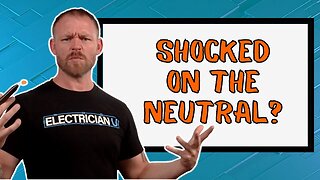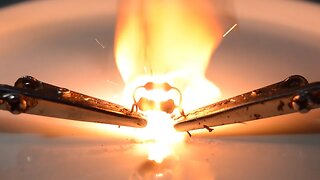How Do You Get Shocked Part2
As electricians we must understand how electricity must travel in loops to be able to work. But what happens when we introduce ourselves into one of those loops? In the latest episode of Electrician U, Dustin walks us through.
🤘⚡️MEMBERSHIP⚡️🤘
JOIN ELECTRICIAN U - become a member and get:
FREE Continuing Education every year
FREE Practice Exams
FREE Monthly Video Courses
FREE Weekly Live Instructor-Led Classes
FREE Monthly Educational Newsletter
Premium Members-Only Content
Private Discord Channel
Monthly Members-Only Discord Chats
Sign up here --- https://www.electricianu.com/electrician-u-membership/
🎧🎹MUSIC AND VIDEO:🎹🎧
https://www.facebook.com/descantmv
🎬✍️ART AND ILLUSTRATION:✍️🎬
https://www.daverussoart.com
Electricity does not travel in straight lines. It must travel in loops. It leaves the source, travels through the load(s), and then back to the source. Without this loop, current will not flow, but will just stop at the point of breakage in the loop (circuit). Let’s talk first about those loops. First, there is a transformer. It could be pole mounted or pad mounted (in essence they are the same). A single-phase transformer is made of 2 complete loops. One on the primary side and one on the secondary side. The primary loop is comprised a wire coming from its source, wound thru the transformer itself, and a wire on the other end of the windings headed back to source. A loop! On the secondary side, its relatively the same, but with one added wire. The secondary windings of the transformer each have a wire leaving on their respective ends that travel to the panel (for a residential application lets assume 240v). There is also a neutral that is tapped onto the center point of the winding, which generates the neutral, so we can utilize 120v if needed.
However, with the panel hooked up to the secondary conductors as we described above, the loop isn’t completed since the phase conductors/neutral conductor are all separate from one another. So, in order for any magic to happen, we need another loop! This would be where the individual circuits come into play. Take a lightbulb for instance. It is also an open-ended loop. To help imagine, think of one entire piece of wire, with one end connected to the screw shell, up into the lamp where its coiled together at the filament, and the other end of the wire connected to the bottom of the lamp. Once a hot conductor leaves the panel (via a breaker) touches the bottom of the lamp, travels thru the filament, and back to the panel on the neutral, the circuit (loop) is complete and current can flow!
But, say we take that hot wire and cut it. We now have a complete loop but its not touching together at the point where we cut it. IF we were to grab hold of one end of the wire in one hand and the other end in our other hand, WE would become a part of the circuit and current would flow THRU us. The same could happen if we used just a finger to bridge the gap between the two cut pieces. The shock would be less as the path is only thru our finger, but a shock would be felt nonetheless! If you were to grab one end in each hand as described above, electricity would pass THRU your heart on the way to your other hand and that can cause SEVERE damage or even death! A parallel circuit shock is similar but in lieu of putting yourself inline with the current flow, you are negating the load entirely by touching each end of the loop. So, grabbing one hot wire in one hand and the other hot (or neutral) in the other, you take the load portion of the loop out and replace it with your body. And since the human body has a very low resistance, a large amount of current will be allowed to flow (as there isn’t a whole lot of resistance to slow it down). That problem is exacerbated by traveling thru your heart as you have an end of the loop in each hand!
Protect yourself from electrical shock! Turn the power off and lock it out! And if you MUST work on something while it is energized, make sure you have the proper PPE available and the proper training. We hope this has been insightful into how electricity travels in loops and how introducing yourself into them can result in a shock. Do you have a topic you would like to see discussed? Leave a comment in the comment section and let us know. Please continue to follow Dustin and Electrician U as we are constantly adding new content to assist our followers in becoming the best electricians that they can be!
-
 13:33
13:33
Electrician U
1 year agoHow Do I Get Shocked? Why Am I Getting Shocked? It's Simple.
156 -
 7:35
7:35
Electrician U
1 year agoCan You Get Shocked From a Neutral Conductor?
249 -
 50:56
50:56
Tool Box Talk For Electricians
8 months agoHow To Wire A 2 Way Switch With Intermediate Switch
165 -
 17:43
17:43
TheSternMethod
2 months agoDID YOU JUST GET SHOCKED?!
8 -
 5:57
5:57
GarageScience
1 year agoHow to Start Electrical Fires ~ Burning/Blowing Up Resistors With Science!!!
12 -
 0:22
0:22
TheCONTENTbible
8 years agoThis 'Touching The Electric Fence' Experiment Went Just As Expected
810K4 -
 23:56
23:56
EPro - Electric Pro Academy
1 year agoWhen An Electrical Job Goes Sideways
521 -
 0:16
0:16
ibobshields93
1 year ago $13.31 earnedMassive amount of static electricity totally shocks woman
9.04K27 -
 1:06
1:06
Larson Electronics - American Made and Manufactured Industrial Lighting and UVC Products
2 years agoExplosion Proof Bug Eye Emergency Exit LED Fixture - Self-Testing- 90 Min. Emergency Runtime- C1D1&2
77 -
 1:28
1:28
Larson Electronics - American Made and Manufactured Industrial Lighting and UVC Products
2 years agoExplosion Proof Disconnect Switch - Class 1 Division 1 - Groups C, D - 240V Rated
13